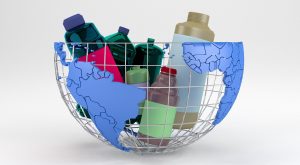Polyethylene terephthalate or polyethylene terephthalate is the material that makes up PET containers. This type of plastic is increasingly used by different economic sectors, thanks to the important advantages it offers, such as its flexibility and lightness, the chemical and thermal resistance it withstands, its resistance to abrasion and breakage, and the fact that it can be easily cleaned.
Despite its significant growth in many other industries, it is in the food industry where the use of PET containers is essential. In addition to the aforementioned advantages, they allow the consumer to see what is inside because they are transparent, have good resistance to breakage and have a significantly lower production cost than other materials, which means lower water and energy consumption
PET is used daily in trays, jars, tuppers, cups or bottles, since it helps contain food products in cold storage and allows liquids and food to be tightly sealed. In addition, it prevents external agents from damaging the flavor or spoiling the food. Its light weight makes it easy to transport, which is key for food distribution chains or catering companies, for example. From the environmental point of view, the use of this type of plastic favors recycling, stimulates a lower consumption of resources for the manufacture of packaging or for its logistic distribution and, also, communicates a message to society about the concern of this industry for the care of the environment
In the case of REPETCO, the company offers a proprietary, nature-friendly, patented system through PET/PE multilayer food packaging of post-consumer origin. By means of a unique process, rPET pellets and rPE are generated that can be reused in the food industry with multilayer PET/PE trays and sheet packaging; in bottles for soft drinks or detergents; and in fibers for the textile and automotive industry.
PET is key for the food industry as it allows food to be preserved without losing properties
Importance in other industries
In the case of many industrial activities, the use of PET facilitates the manufacture of engines or packaging that can withstand very low temperatures in acidic environments. Among the segments that make most use of it are the cosmetics and healthcare sectors, where PET containers are indispensable for marketing certain sensitive liquids and medicines, as well as products that require specific conditions for their preservation, such as medicinal oils, certain drugs or talcum powder.
In other sectors, such as textiles, the use of recycled PET is a trend both from a fashion point of view and as a way of expressing the commitment of brands to care for the environment. One of the most common systems in this sector is the recycling of plastic material into chips and fibers through a process called polymerization, which are later melted in rows to form cords and, with them, yarns that are put together on spools. From there, they are transformed into polyester fibers which, mixed with other elements, are used by factories to produce completely new garments.
Another industry that has been betting heavily on the use of PET for decades is the automotive industry. The manufacture of parts using this material brings a host of advantages to the companies that use it, often even replacing steel, the traditional king of this sector. The use of plastic allows, among other advantages, to achieve a significant reduction in the weight of the parts, which favors better aerodynamics of the vehicles. In addition, its use in the finishing of the interiors favors greater acoustic insulation. Industry giants such as Ford, Toyota and Maserati have been using plastic in their production plants since the 1990s.
Sectors such as the automotive, pharmaceutical and textile industries have achieved multiple benefits thanks to the use of PET
Other articles of interest: The main advantages of rPET packaging over other packages







